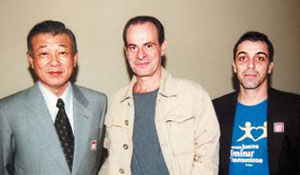|
REPORT FROM BRAZIL
MORHAN's Vital Contribution
For 23 years, MORHAN has been fighting to eliminate leprosy from Brazil, as National Coordinator Artur Custodio Moreira de Sousa relates.
“Before MORHAN, we walked with our heads bowed. Today, we hold our heads up because we recognize we are part of society.” This assertion by Cristiano Torres, MORHAN coordinator for Para State, Brazil, highlights the important role of MORHAN (Reintegration Movement for People Affected by Hansen's Disease) in working to eliminate Hansen's disease and the prejudice that surrounds it.
Established on 6 June 1981 by the charismatic Francisco Nunes “Bacurau,” who himself had overcome the disease, MORHAN was part of the explosion in social movements fighting for democracy and human rights that emerged in Brazil in the 1980s. Its history is thus closely bound up with people working to advance the cause of human rights and public health in Brazil.
It was one of the first advocacy groups in the world formed by people affected by Hansen's disease, and its founders believed that only through mobilizing volunteers who had not had the disease could the disease be eliminated and prejudice overcome. Today those volunteers include everyone from ordinary citizens to some of Brazil's best-known celebrities, among them singers Ney Matogrosso and Targino Gondim, actor Ney Latorraca, actresses Solange Couto, Karla Karenina and Elke Maravilha, clothing designer Lino Vilaventura and painter Siron Franco.
Brazil's first cases of Hansen's disease occurred some 500 years ago among Europeans and slaves from Africa. As in other countries, the subsequent history of those affected was marked by pain, suffering, prejudice, isolation, ruined families and shattered lives.
Brazil didn't officially eliminate the practice of isolating patients until 1962 (although not every state followed through). Then, in 1981, the World Health Organization officially recommended that endemic countries adopt multidrug therapy. This prompted social organizations to begin campaigning against the stigma and prejudice associated with the term leprosy. The health ministry decreed that the term hanseniase (Hansen's disease) be used instead, and eventually this became law after considerable pressure from MORHAN.

(from left) Yohei Sasakawa, singer Ney Matogrosso and MORHAN's Artur Custodio |
Key Objectives
The main goal of MORHAN is to inform society that Hansen's disease can be treated and cured, and, with hard work, completely eliminated. To achieve this, MORHAN has set the following targets:
・Help cure, rehabilitate and socially reintegrate people affected by the diease
・Work to eliminate the prejudice they face at home, at work and in the community
・Ensure that those affected by Hansen's disease can freely exercise their rights as citizens
・Transform old hospital-colonies where patients were isolated from society and their families into places where they are treated with respect, educated about their disease and given access to cultural and recreational facilities that help build up their self-esteem and improve their quality of life.
These goals are justified by the high incidence of Hansen's disease in Brazil, where there were 79,908 registered cases at the start of 2004, or a prevalence rate (PR) of 4.52 per 10,000 people. In 2003, 49,026 cases were registered, or a new case detection rate of 2.77/10,000.
In the fight to reduce the PR, MORHAN has been campaigning to prevent and control the spread of the disease, both in conjunction with the health ministry and through MORHAN's regional branches. Today MORHAN is represented in 24 of Brazil's 27 states and gives support to more than 100 communities. It also works together with other social organizations to pressure the authorities to fulfill their social and public obligations with regard to the treatment and cure of Hansen's disease.
MORHAN T-shirt: “Together we can eliminate Hansen's disease.”
The participation of Cristiano Torres in the Olympic Torch Relay was an event of enormous symbolic value.
In 2002, in the run-up to the presidential election, MORHAN started a dialogue with the candidates. Only two - Luis Inacio “Lula” da Silva and Antonio Garotinho - included the elimination as part of their platform. Lula, who is now president, went further and signed a document declaring that if elected he would fight leprosy.
Two years passed, at which point MORHAN publicly aired its dissatisfaction with the government's performance, quoting author Dana Carpender's definition of insanity - “doing the same thing for many years, waiting for different results.” The following month, the health ministry announced changes in the way the leprosy elimination program was to be coordinated and the expansion of the national plan to eliminate Hansen's disease.
Soon after, another event with enormous symbolic value occurred: the participation of Cristiano Torres in the Olympic Torch Relay for the 2004 Athens Olympics. Torres, who publicly declared he once suffered from Hansen's disease, is perhaps the first person in the world affected by the disease to have taken part in the relay.
Through his participation and statements to the media, Torres demonstrated that fighting for a worthwhile life free of prejudice can produce winners.
More recently, WHO Goodwill Ambassador Yohei Sasakawa visited Brazil. He met with representatives of the health and justice ministries and gave his support to MORHAN's efforts. He urged the authorities to do their best to meet the goal of elimination while reminding them not to overlook the prejudice and stigma people face even after they have been cured of the disease.
Looking ahead, MORHAN will promote the first National Conference of Inhabitants of Old Hospital-Colonies. The purpose is to gather material to include in a report that will serve as a study on what action can be taken at the national level to improve their quality of life. MORHAN is also putting together the first National Exhibition of Cultural Manifestations for the Elimination of Hansen's Disease, which is intended to demonstrate that in order to reduce discrimination, it is necessary to involve all members of society, especially young people.
With the medical progress that has been made, MORHAN believes it is unacceptable to see children affected by Hansen's disease or suffering visible deformity as a result. With the help of our volunteers, we will continue to campaign until we achieve a just society free of Hansen's disease and its accompanying prejudice.
ELKE MARAVILHA: ELIMINATION CAMPAIGNER
She's one of the best-known actresses in Brazil through her work in film and television. But there's another side to Elke Maravilha that is less well-known. For the past 15 years, she has been visiting leprosy colonies to spend time with former patients and their families.
Born in the Soviet Union to a Russian father and German mother, Elke went to Brazil right after World War II and struggled for a long time before finally establishing herself as an actress.
Never forgetting the hardships she went through in her own life, Elke now makes time to help leprosy patients, prison inmates and prostitutes, sharing their pain and encouraging them to have hope for the future.
She works closely with MORHAN, a Brazilian NGO fighting leprosy, and is an active participant in campaigns for eliminating the disease and the social stigma attached to it.
“My former husband asked me if I kissed leprosy patients,” the actress told WHO Goodwill Ambassador Yohei Sasakawa during his recent visit to Brazil. “I said ‘Yes’ and he started hating me. So I divorced him,” she recalls with a laugh.
“I'm now happily remarried, and I share my happiness with those who are less fortunate.”
 Elke offers a message of hope
|